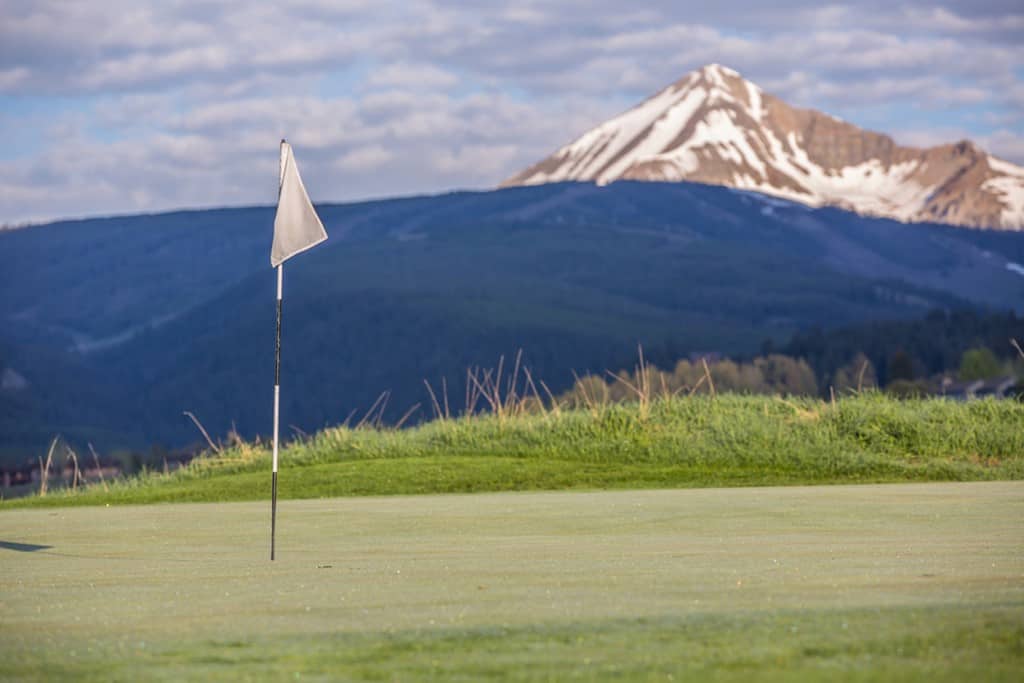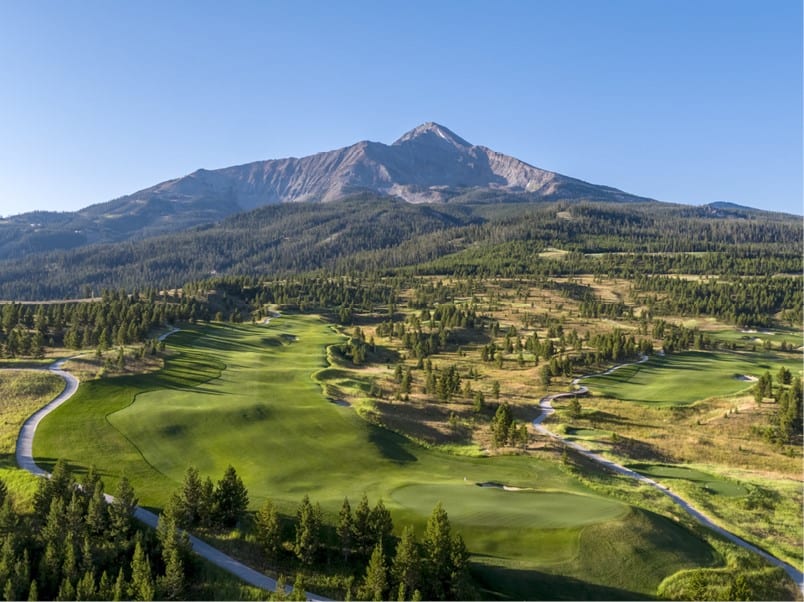
When your golf season is maxed out at 150 days, every round counts.
As does every detail. From man to beast to blade.
In Big Sky, Montana, elevated expectations are literal, with courses situated amid a setting reaching 7,500 feet above sea level.
As COVID-19 passed from stages of initial alarm to mandated sequesters to measuring risk to pent-up needs for distanced expeditions, the social distancing of the Treasure State saw an unexpected rise in both tourism and home sales.
“Rise” is actually putting it mildly. In the late summer and early autumn, the nation's fourth-largest geographic state — with more than 147,000 square miles of space — experienced a mountain-sized boon in bustle and business.
Echoing the country’s ubiquitous, pandemic-driven ascent in round counts across the summer months, Montana, with just 116 courses inside its borders, is counted among a “Mountain Region” of states that saw a 11.2 percent year-over-year upturn in rounds played through September, according to Golf Datatech. The inflation of play tracks as the third largest for any region in the country.
Traditionally revered for its outdoorsmen’s bounty of skiing, fly fishing, hiking, rafting, hunting and beyond, Big Sky’s mesh of a mere four courses (three private, one public) may be minute in count, but that hasn’t resulted in any abstention from the round rush, with folks coming in from all corners of the country.
Lone Mountain Land Co., owner of Big Sky member community clubs Spanish Peaks and The Reserve at Moonlight Basin, saw summer membership arriving from across the country, with folks seeking enhanced Montana time during the COVID-19 summer. “Most of our members are coming from bigger cities, whether that be Chicago, down South or coming from L.A.,” says Nick Berasi, head golf professional at The Reserve at Moonlight Basin.
And it’s not just the regulars seeking more elbow room amid the times of pandemic.
“Hearing from my real estate colleagues, they anticipated a slow season — now, they’re experiencing record sales,” Berasi says. “It’s booming.”
More sales equaled more stay equaled more play equaled more expectations for Berasi and Moonlight’s grounds team. The Jack Nicklaus-designed beauty of a beast at 8,000 yards from the tips and situated across the elevated grandeur of better than 800 acres of mountain terrain is no task for the timid — whether playing or maintaining the turf.
“Mother Nature and elevation dictate our course practices,” Berasi says. “Getting ready for a long winter at over 7,200 feet, it limits the amount of time for our season. Even though the summers are beautiful, we are working with a compacted time frame.”
Such compact sees around three-and-a-half months of golf. Rare — if ever — is there a play day to spare.
“With a 100-day season, we can’t close for a day of the week. I’ve worked at courses where, say, the course is closed on Mondays for the maintenance staff. Here, we can’t close for that day.” says Berasi, adding that tee times are adjusted to begin at 10 a.m. twice per week, allowing crews opportunity to complete work ahead of play. “We’re a destination, so if a member is out here for just one week, we can’t take that day away from their trip.”
Of course, for Montana mountain enthusiasts, golfer care is paired with a thorough purview of the natural surrounds. To wit: Every player or employee cart at Moonlight is affixed with bear spray.

“There’s a healthy black bear population out here,” Berasi adds. “Operationally, we can’t have any outdoor trash receptacles, so we ask people keep trash in the cart and we’ll handle it when golfers come back in. Bear aware. We have the bear spray in every cart. Nobody has had to use it, but we wouldn’t let our members or guests or staff go out without that spray, just in case.”
Of more enhanced agronomic concern is what moose and elk can do to pristine greens.
“There’s also a high population of deer and elk,” Berasi says, “and a 700-pound elk can do some serious damage to greens. For some reason, they’re really attracted to the flags — either they love or hate those flags. I’m not sure if anybody truly knows. So we pull all the flags at night.”
As early fall marks the transition season, the Moonlight team readies for winter.
After applying applicant on bentrgrass greens and tees to winterize surfaces and protect from snow mold, Moonlight’s head superintendent Garrett Turner and crew prep for snowfall.
“We put snow fencing all along the greens and tees, so we want to hold as much snow as we can, to keep that surface level from freezing,” Berasi explains of Turner’s tasks. “A good snow year for us — maybe six feet — is actually better for the course. Of course, the grass is dormant beneath that blanket, but it’s still alive and it’s protected from the winds.”
Temps dictate success patterns.
“This past year, we had a lot of early-season snow, followed by super cold weather, then back to 50-degree days,” Berasi says. “So, the snow melted and created ice at night — and that’s a killer. We had a few ice burn patches.”
High elevations are matched with high expectations for premier conditions.
“This season, you could initially see the signs of a hard winter, but come July we had cross-seeded, tilling down into the soil. That worked very well, and those areas grew back nicely,” Berasi adds. “Come spring, we were out there hand-shoveling all the greens and tees and getting some sunshine on those surfaces. By early May, we’re mowing.”
About 20 miles — and also around 1,200 feet — down the mountain, Big Sky Golf Course is part of the eponymous resort and has been operating since 1973. One of the first Arnold Palmer designs when it initially opened as a 9-holer, the public grounds enjoy a season lasting about 140 days.
“We could stay open a bit longer, but because of the necessary cultural practices and managing expenses, we find it better to set a hard date,” says Mark Wehrman, the course’s head golf professional. “Some years you feel real smart for doing it, and other years, well, there’s some hindsight, looking back and thinking maybe we could have stayed open a few more weeks.”
Akin to its private play neighbor up the way, Big Sky seeks to maximize its compact season. As snow arrives and temps fall, Big Sky superintendent Sam Woodger and his staff aerate about two weeks before closing, followed by wall-to-wall course treatment and then blowing-out irrigation.
“The heathier your turfgrass can be heading into winter — considering that this course sits under four feet of snow for five months — the healthier that turf can be going into the cold season and the better it will come out in spring,” Wehrman says. “There’s some juggle to get the greens aerated and picking the right cocktail of season-ending fungicide. We’re always working to protect against the snow mold.”
Ever aiming for ideal conditions amid the short season, Wehrman and Woodger have discussed solid-tining in fall, and then coming back in early May to core, all in an effort to be less invasive. “The thought process being that golfers don’t expect perfect conditions on May 20, but they want ’em on September 15,” Wehrman explains.
And while his public resort track is in a more populated area, the task of being constantly attuned to local wildlife sees no descent.

“The main challenges are with the elk. They move in herds and, come fall, when arrows and bullets start flying by their heads, they start seeking lower elevations,” Wehrman says. “Sometimes, I’ll see herds up to 300 of them. And when they get on the greens and in the bunkers, there can be some real damage. And, apparently, they really hate the flagstick, so they’ll try and knock the pole out of the ground.”
Like Moonlight, being bear aware is crucial on a daily basis.
“We've got to get every piece of trash off the course every night. If you’ve got any bear attractants out there, you’ll show up in the morning and there’s a mess,” Wehrman says. “We’ve got to do our part to make sure they’re good bears.”
For public and private grounds alike, seasonal splits between ski and swing seasons translate to seasonal gigs for employees. At Moonlight, a grounds team of 30 employees in-season goes to about 10 workers come winter.
“Once the course is set, they’ll transition into our snow removal team, plowing residential driveways,” Berasi says. “And a lot of the course equipment is multi-purpose and can be used for the snow removal work.”
Big Sky Resort presents its golf staff with all manner of winter opportunities, while the course brass often trades TaylorMade for Rossignol. Woodger has a snow removal business in winter and the course’s assistant head pro manages ski instructors at a resort. “Most of our staff goes to winter positions, whether it be ski instruction, rentals, patrol, lift, retail,” says Wehrman, who has, on occasion, managed a ski rental shop.
Across a most atypical year, as the landscape turns from green to white, the bounty of Big Sky is a golf canvass graduating with the unlikely times.
“Initially, a lot of those folks came here for the ski attraction, but with COVID over the summer, the natural social distancing found people staying here,” Berasi says. “Typically, we might see members and their families come out here for a few weeks in the summer. This season, it’s been two months.”

Explore the November 2020 Issue
Check out more from this issue and find your next story to read.
Latest from Golf Course Industry
- Audubon International announces newest leadership appointees
- Southern golf trifecta
- Sports for Nature Framework gains new signatories
- Camiral Golf & Wellness upgrades Stadium Course
- Troon selected to manage The University Club of Milwaukee
- Kafka Granite adds new business development manager
- GCSAA celebrates 10-year anniversary of collaboration with Congress
- DLF launches new seed enhancement solution





